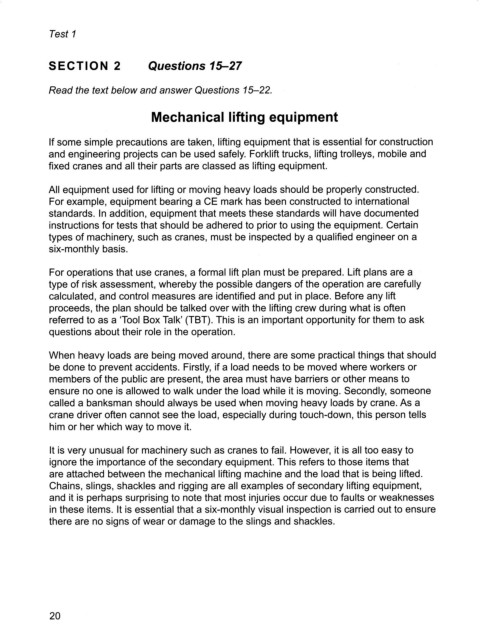Page 315 - Cam General 15-16-17-18-19
P. 315
Test 1
SECTION 2 Questions 1ι27
Read the text below and answer Questions 15-22.
Mechanical lifting equipment
If some simple precautions are taken, lifting equipment that is essential for construction
and engineering projects can be used safely. Forklift trucks, lifting trolleys, mobile and
fixed cranes and all their parts are classed as lifting equipment.
All equipment used for lifting or moving heavy loads should be prope「ly constructed.
For example, equipment bearing a CE mark has been constructed to international
standards. In addition, equipment that meets these standards will have documented
instructions for tests that should be adhered to p「ior to using the equipment. Certain
types of machine「y, such as cranes, must be inspected by a qualified engineer on a
six-monthly basis.
For operations that use c「anes, a formal lift plan must be prepared. Lift plans are a
type of 「isk assessment, whereby the possible dangers of the operation are carefully
calculated, and control measures are identified and put in place. Before any lift
proceeds, the plan should be talked over with the lifting crew during what is often
refer「ed to as a 'Tool Box Talk’(TBT). This is an important oppo同unity for them to ask
questions about their 「ole in the operation.
When heavy loads a「e being moved around, there are some p「actical things that should
be done to prevent accidents. Firstly, if a load needs to be moved where workers or
members of the public are present, the area must have barriers or other means to
ensure no one is allowed to walk unde「 the load while it is moving. Secondly, someone
called a banksman should always be used when moving heavy loads by crane. As a
crane driver often cannot see the load, especially during touch-down, this person tells
him or her which way to move it.
It is ve叩 unusual for machinery such as cranes to fail. However, it is all too easy to
ignore the importance of the seconda叩 equipment. This refers to those items that
are attached between the mechanical lifting machine and the load that is being lifted.
Chains, slings, shackles and rigging are all examples of seconda叩 lifting equipment,
and it is perhaps surprising to note that most inju「ies occur due to faults or weaknesses
in these items. It is essential that a six-monthly visual inspection is carried out to ensure
there are no signs of wear or damage to the slings and shackles.
20

